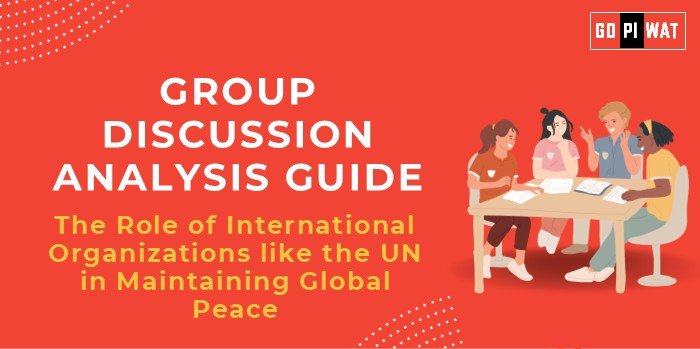📋 Group Discussion (GD) Analysis Guide: The Role of International Organizations like the UN in Maintaining Global Peace
🌐 Introduction
- 📖 Opening Context: “In an era of geopolitical uncertainty and rising conflicts, the role of international organizations like the United Nations is more critical than ever in promoting global peace and stability.”
- 📚 Topic Background: The UN, established in 1945, operates as a multilateral platform to prevent wars and facilitate peaceful resolutions. With over seven decades of experience, it continues to lead peacekeeping missions, humanitarian relief efforts, and global campaigns for disarmament and sustainable development.
📊 Quick Facts & Key Statistics
- 🌍 UN Peacekeeping Missions: 12 active missions with 62,500 personnel as of March 2024, supported by a $6.1 billion budget.
- 💰 Global Defense Spending: $2.44 trillion in 2023, a 6.8% rise amid escalating conflicts.
- 🛡️ Refugee Crisis: Over 110 million forcibly displaced individuals worldwide by mid-2023.
- 📉 Conflict Reduction: UN peacekeeping has reduced the risk of conflict relapse by 40% in post-civil war nations.
🧑🤝🧑 Stakeholders and Their Roles
- 🏛️ The UN and Its Agencies: Lead peacekeeping and humanitarian efforts (e.g., UNHCR, WFP).
- 🌐 Member States: Fund initiatives, deploy personnel, and formulate policies.
- 🤝 Non-Governmental Organizations (NGOs): Provide ground-level implementation and advocacy.
- 🌍 Regional Bodies: Complement UN efforts (e.g., African Union in regional conflicts).
- 🗳️ Global Citizens: Advocate for peace and accountability through activism.
🏆 Achievements and Challenges
🎉 Achievements:
- 📉 Conflict Prevention: Risk of relapse reduced by 40% in post-civil war countries.
- 🌍 Peacekeeping Effectiveness: Stabilized regions like Liberia and Sierra Leone.
- 🤲 Humanitarian Aid: Addressing the needs of over 110 million displaced persons globally.
- 📋 Policy Advocacy: Global disarmament treaties and Sustainable Development Goals (SDGs).
⚠️ Challenges:
- 💰 Underfunding: $6.1 billion for peacekeeping contrasts with $2.44 trillion global defense spending.
- 🏛️ Political Limitations: Veto powers hinder action in crises like Syria.
- ⚡ Operational Gaps: Challenges in deploying and sustaining missions in volatile regions.
🗣️ Effective Discussion Approaches
📌 Opening Approaches:
- 💰 Highlight the disparity between defense spending and peacekeeping budgets.
- 🛡️ Use the refugee crisis as a humanitarian call for UN intervention.
🎭 Counter-Argument Handling:
- Acknowledge inefficiencies, propose reforms (e.g., equitable funding, veto limitations).
- Present data-driven solutions to address operational gaps.
🔍 Strategic Analysis of Strengths & Weaknesses
- ✅ Strengths:
- Global representation.
- Proven track record in conflict stabilization.
- ❌ Weaknesses:
- Financial dependency on member states.
- Bureaucratic delays.
- 📈 Opportunities:
- Strengthening regional partnerships.
- Adopting advanced technologies like AI for conflict prediction.
- ⚠️ Threats:
- Rising nationalism and isolationism.
- Climate-related conflicts.
📖 Structured Arguments for Discussion
- ✅ Supporting Stance: “The UN’s peacekeeping efforts have demonstrably reduced conflict relapse risks by 40%, emphasizing its critical role in global peace.”
- ❌ Opposing Stance: “The UN’s financial constraints and structural inefficiencies limit its ability to respond swiftly to conflicts.”
- ⚖️ Balanced Perspective: “While the UN has made significant strides in peacekeeping, reforms are essential to meet modern challenges.”
🎓 Connecting with B-School Applications
- 📘 Real-World Applications: Insights into conflict resolution and organizational management applicable to global business challenges.
- 📋 Sample Interview Questions:
- “What lessons can businesses learn from UN peacekeeping operations?”
- “How would you prioritize resources in a crisis scenario?”
- 💡 Insights for B-School Students:
- Develop negotiation skills.
- Explore global leadership in cross-cultural settings.


